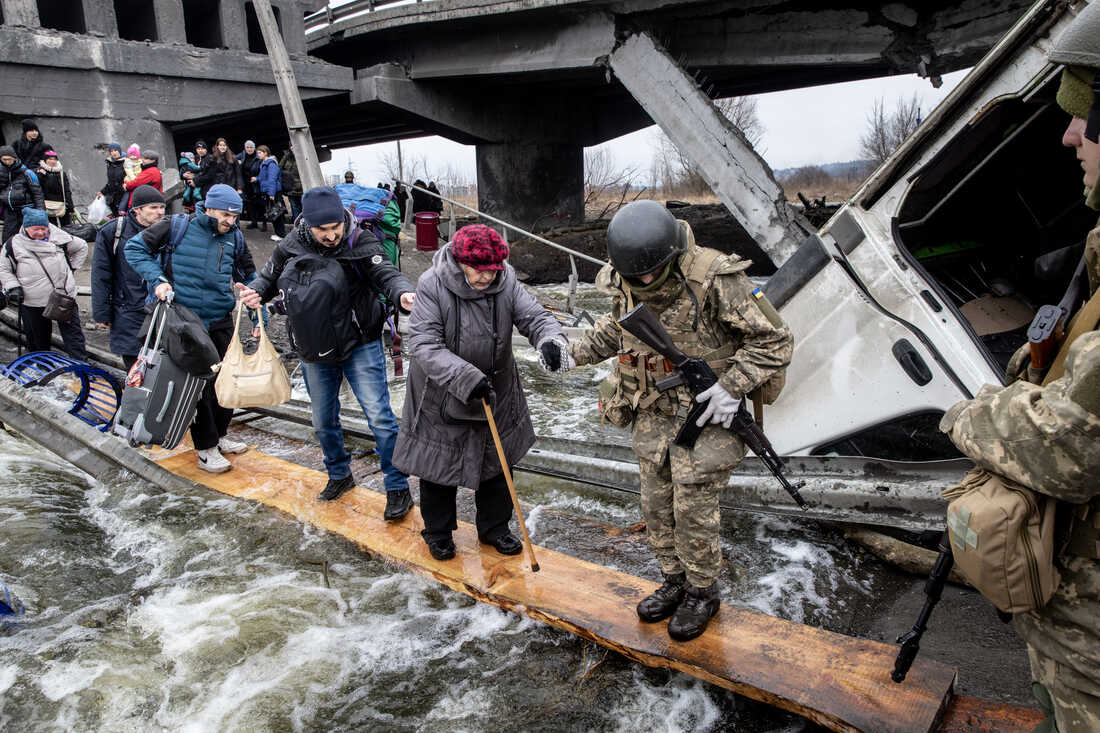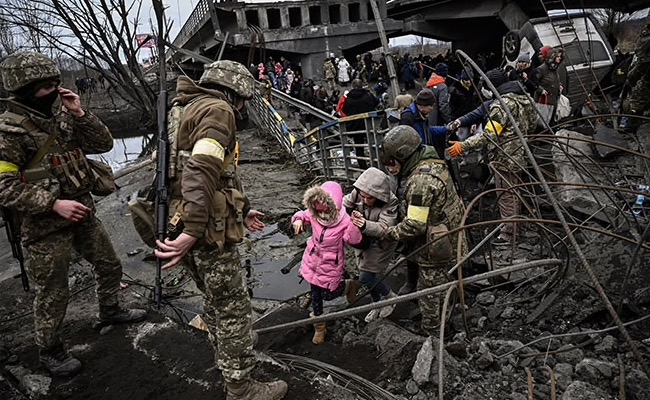Photo courtesy of NDTV.
Russian President Vladmir Putin’s invasion of Ukraine has caused rippling effects throughout the world.
But not everyone understands it, and not everyone understands international politics, let alone national politics. Slice of Culture brought on Journalist, Socialist and Code Pink’s Weekend Social Media Manager Sam Carliner for a conversation on the Russia-Ukraine war.
Carliner is also a writer for Left Voice, a socialist publication, and has had his work published in Teen Vogue and Common Dreams, to name a few. He also wrote an opinion piece of Julian Assange for Slice of Culture in October of 2020.
In Part 1, Carliner gave the background of how history between Ukraine and Russia played a huge part in the invasion. In Part 2, Carliner will go further in depth on the ongoing attacks.
As of Friday, Russian airstrikes were launched in Ukrainian airfields, but Russia’s military haven’t made major advances; they have not moved closer to the capital, but have been bracing for an attack, NPR reported. Russian troops abducted Mayor Ivan Fedorov of Melitopol in southern Ukraine, they added.
The U.N. says at least 564 civilians have died so far in the war, but the toll is probably much higher, The New York Times reported.
Related: RUSSIA-UKRAINE WAR: BREAKING DOWN HOW WE GOT HERE
Sam:
So he essentially had not gotten really any signals from the Biden administration that Ukraine would stay out of NATO. And so he started making these troop deployments and a lot of them were like specific military formations. So it’s not like he was just shuffling troops.
It was specifically like he was shuffling them in a way to show like, “Hey, if we don’t get an answer from the U.S. and NATO on this we’re prepared to take military action.”
Sam:
And that prompted discussions between the US and Russia over this whole question of whether or not Ukraine would join NATO. Essentially within these talks, the US negotiators and the Russian negotiators, didn’t reach an agreement because Russia was putting its foot down in terms of, “We can’t pull back if there’s no guarantee that Ukraine won’t join NATO.” And the US was saying, “we’re not gonna guarantee that Ukraine won’t join NATO.”
Sam:
So for a while, these talks were ongoing and then it was, oh, it feels like a month ago, but I think it was only like two weeks ago, maybe that things escalated.
Essentially there was fighting in the Donbas region, which is a part of Eastern Ukraine with very different tendencies among the Ukrainians.
There are a lot there that identify with a lot of Russian culture and history. I think some who are ethnically Russian, and then there’s still the case that there’s also Ukrainians who want to join NATO, want to be more in the west orbit.
Sam:
And a point I really wanna reiterate is that while both these groups exist, a lot of Ukrainians just don’t want to be in a war. Like they don’t want to be essentially this ground for proxy warfare between major world powers.
But because of the fighting that was going on in Donbas, Putin essentially used the moment to say “I’m sending in troops.” I mean, he called them peacekeeping forces, but they were troops, and recognizing these two areas of the Donbas as independent republics.
So that was like a huge violation of international law. So that sent a lot of fear to people that, “Oh, maybe he actually will take more military action” and (would) essentially (get) a big response from the US and also NA powers was, if he takes military action, we will sanction him.
Sam:
This whole time, while Putin was sort of doing his military maneuvers along the border, a lot of times there was also a troop buildup within Europe of the US sending its own troops; European countries signaling that they might take military action…And I think it’s really important for people to understand how a lot of this like fostering back and forth is how we got here.
It’s that the whole, “Oh, well I’m gonna make my military look more extreme.” Then the other side goes, “I’m gonna make my military look more extreme” (and) when you do that for long enough, you eventually get to a point where you can’t do anything else other than one side or the other takes military action.
Sam:
In this case, it was Putin and, again not justifying (it), but I think it is important that people understand that this is sort of always the case in history when two sides of a conflict are sort of building up their militaries and making threats that can only go on for so long before one side acts.
So, we saw that particularly on Tuesday where, I mean the day that we all remember now, where Putin announced that he would be taking military action. He sent a bunch more troops into Eastern Ukraine (and) he was bombing what looked like he was just bombing military targets, which doesn’t make it, doesn’t make it okay.

I do refrain to some extent from making exact claims of what combat on the ground has looked like, because I follow wars a lot, but I’ve never been to a warzone. So there’s only so much I can say from experience of course.
I think no one should deny at this point that the Russian military is waging just an assault on Ukraine.
But in terms of the details of different stories, there’s also been claims of atrocities towards Russians. There’s claims of atrocities towards Ukrainians. There’s now a lot of stories going on about Black and African and South Asian immigrants are refugees being kept from leaving.
So in terms of all these reports we’re hearing on the ground, I would suggest that people should not completely disregard the stories they’re hearing. It is very likely that a lot of these things are true because when war happens, really horrible things happen.
But I also definitely think people should be cautious of how much they’re basing their understanding of what’s going on off of like these stories they’re hearing because in a lot of ways, misinformation is based on really hitting at people’s emotions and having them act in certain ways.
Adrienne:
Right. Right. And I know that when I texted you to do this with me, I know you mentioned that, you know, there’s been a lot of misinformation that’s being spread or incorrect reporting and what not. So could you just name a few of the misinformations that you’ve been seeing?
Sam:
Yeah. I mean, one thing is that you don’t really hear – at least in the US – about NATO’s role in essentially moving closer and closer and heading into these talks and not really taking into consideration Russia’s security concerns.
I mean, one thing that I think people should understand is that, again this does not at all justify what he’s doing, but I do think people should understand that like Putin had said time and time again, that if NATO keeps expanding, if it deploys more troops closer to Russia, if it keeps expanding, then Russia will take military action and a lot of US and European leaders were like, “Oh, well, he’s just bluffing. So let’s like, keep poking the bear and I think that was irresponsible of them.
Sam:
One thing I wanna say is that there are far right groups on the ground in Ukraine, even within the Ukrainian military, which is essentially in the Nazi group militia that the US is arming, but also Russian disinformation is putting out this idea that like, “Oh, like this is necessary because there’s Nazis and we’re only like waging war against Nazis.”
And, you know, I follow left spaces and there are people in left spaces who are falling for this, so in case any of your readers or those people see that, that is also disinfo.
Yes, there are, there are far right groups, but this is a war that is harming Ukrainians who just wanna live their lives.

I did also wanna say people are suggesting different ways for the US and NATO to take action. The two big things I’ve seen are calls for sanctions and calls for a no fly zone.
Adrienne:
Right.
Sam:
I think people should understand, and I can explain more like what these specific policies are, but these are policies that whether or not they’re painted as being a way to punish Putin, they’re actually types of warfare, largely directed at civilians and they risk harming a lot of civilians and further escalating the conflict.
Stay tuned for Part 3, which will be posted next week. Follow @sliceofculture on Instagram to stay up to date.



1 thought on “Russia-Ukraine War: Inside The Invasion”